Relations and Functions NCERT Solutions
NCERT Exercise 1.2
Question: 1. Show that the function f: R* → R* defined by F(x) = 1/x is one- one and onto, Where R* is the set of all non- zero real numbers. Is the result true, if the domain R* is replaced by N with co- domain being same as R*?
Solution:
Let x1 ≠ 0 and x2≠ 0 ∈ R*
Here f(x) = 1/x Then,
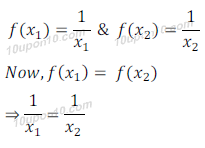
⇒ x1= x2
So f is one - one function.
Let f(x) = 1/x = y ≠ 0 ∈ R* ( codomain of f)
⇒ x = 1/y ∈ R* ( domain of f)
So, f is onto function.
When domain R* is replaced by N and codomain remains same then f:N →R
Let x1, x2 ∈ N
Then,

⇒ x1= x2
So, f is one- one function.
But every real number belonging to co–domain may not have a pre image in domain of natural numbers.
Here 3/5 ∈ R
But 1/3 = 5/3 ∉ N
So,f is not onto function.
Question: 2. Check the injectivity and surjectivity of the following functions:
(i) f:N → N given by f(x) = x2
(ii) f:Z → Z given by f(x) = x2
(iii) f : R → R given by f(x) = x2
(iv) f : N →N given by f(x) = x3
(v) f: Z → Z given by f(x) = x3
Solution:
(i) Here f (x) = x2
Let x1, x2 ∈ N then
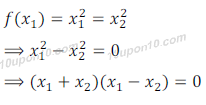
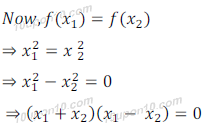
Since, x1, x2 ∈ N
So, x1 + x2 = 0 is not possible.
∴ , x1 – x2 = 0
⇒ x1 = x2
∴ f (x1) = f(x2) ⇒ x1 = x2
So, f is injective function.
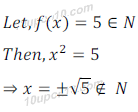
So, f is not surjective function.
(ii) Here f(x) = x2
Let, x1, x2 and x2 = – 3 ∈ Z

Therefore, f (x1) = f(x2) but x1 ≠ x2
So, f is not injective function.
Let f(x) = 5 ∈ Z
∴ x2 = 5 ⇒ x ≠ √5 ∉ Z
So, f is not surjective function.
(iii) Here f (x) = x2
Let, x1 = 4 ∈ R
And x2 = – 4 ∈ R

∴ f(x1) = f (x2)
but x1 ≠ x2
So, f is not injective function.
Let f(x) = – 3 ∈ R
∴ x2 = – 3 ⇒ x = ± √ – 3 ∉ R
So, f is not surjective function.
(iv) Here f(x) = x3
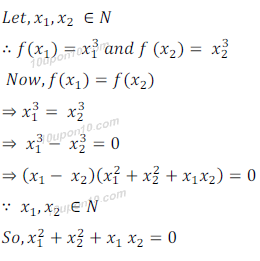
Which is not possible.
∴ x1 – x2 = 0
⇒ x1 = x2
∴ f(x1) = f(x2)
⇒ (x1) = (x2)
So, f is injective function.
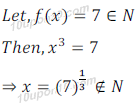
So, f is not surjective function.
(v) Here f(x) = x3
Let, x1, x2 ∈ N
Then,
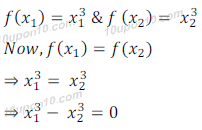

Which is not possible.
∴ x1 – x2 = 0
⇒ x1 = x2
∴ f(x1 = f(x2)
So, f is injective function.
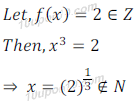
So, f is not surjective function.
Question: 3. Prove that the Greatest Integer Function f: R→R, given by f(x) = [x], is neither one-one nor onto, where [x] denotes the greatest integer less than or equal to x.
Solution:
Let x1 = 3.5 and
x2 = 3.2 ∈ R;
Here f (x) =[x]
Then, f(x1) =[3.5] = 3
and f (x2) = [3.2] = 3
Now f(x1) = f(x2)
But x1 ≠ x2
So, f is not one - one function.
Let f(x) = 2.2 ∈ R
Then [x] = 2.5 which is not possible because there is no value of x corresponding to which [x] = 2.5.
So, f is not onto function.
Thus f is neither one-one nor onto function.
Question: 4. Show that the Modulus Function f: R → R given by f(x) = |x| is neither one-one nor onto, were |x| is x, if x is positive or 0 and |x| is –x if x is negative.
Solution:
Let x1 = 2 and x2 = –2 ∈ R
Here f(x)=|x|
Then f(x1) =|2| = 2 and
f(x2) = |–2| = 2
Now f(x1) = f (x2)
but x1 ≠ x2
So, f is not one-one function.
Thus f is neither one-one nor onto function.
Question: 5. Show that the Singnum function f:R → R given by  is neither one-one nor onto.
is neither one-one nor onto.
Solution:
Let x1 = 2 > 0 and x2 = 3 > 0 ∈ R
Then f(x1) = f (2) = 1 and f(x2) = f (3) = 1
Now f(x1) = f ( x2) but x1 ≠ x2
So, f is not one-one function.
There is no value of x for which f(x) = 3 because range of f is |–1, 0, 1|
So, f is not onto function.
Thus f is neither one-one nor onto function.
Reference: